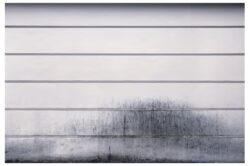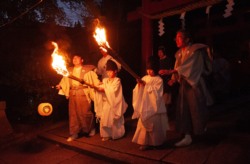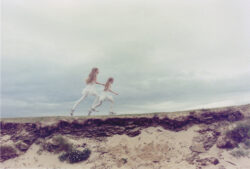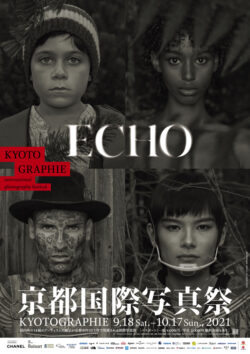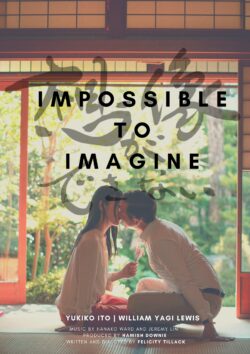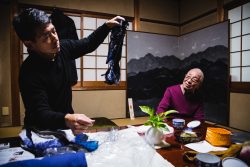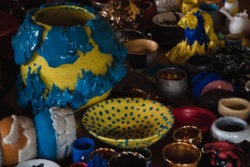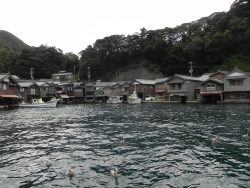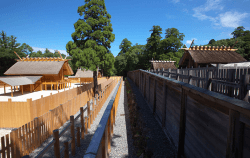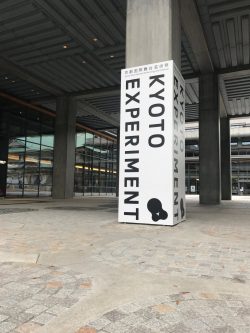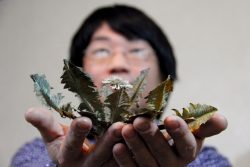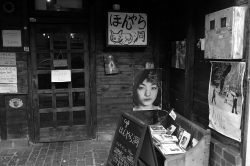Creative Kyoto
White Lines
Horizontal lines on an earthen wall. Found on the outer walls of temples, some shrines, and the Imperial Palace, these lines indicate close historical ties to the Imperial family. Some temples have three or four lines, but the walls of monzeki jiin, where members of the Imperial family have served, are decorated with five.
Throughout the city of Kyoto, these lines are so ubiquitous as to go unnoticed by visitors and residents alike. For me, they have a mysterious beauty. Amidst all the classic scenes of Kyoto, I have found myself photographing these simple walls again and again. They are images which were literally painted by the weather.
Read MoreInvitation to contribute – KJ 107 (Fire & Kyoto)
Fire transforms, renews and purifies. It is deeply embedded in the culture of Kyoto as a powerful destructive force, sacred agent and essential component of everyday life. The Repeated disastrous conflagrations over its long history have left an indelible mark on the psyche of the city, even today. Fire remains an integral part of spiritual and cultural practices in Kyoto, and the prevention of fire is an ever-present concern.
Read MorePhotography Without Borders: Kyotographie 2023
One of the pleasures of KYOTOGRAPHIE has always been the opportunity to explore Kyoto spaces that are not normally open even to longtime residents, and to appreciate the imaginative ways in which the exhibitions have been staged in them. This year, the number of main venues has expanded to 15, while their geography has contracted, presumably to accommodate the influx of day trippers and international visitors. At the same time, the number of KG+ satellite exhibitions in far-flung locations around town has increased to 92, in addition to the 10 KG+ Select and 9 Special exhibitions.
Read MoreKYOTOGRAPHIE 2022 “One”
Writing in their preface to the first KG catalogue, Reyboz and Nakanishi averred that “KYOTOGRAPHIE’s intention was always to stage the work in the shrines, temples, machiyas, tea houses and other emblematic locations of the city. But by using scenographers and designers to ensure that the photography and the venues will each work to enhance the other, it was our hope that by engaging the participation of Kyoto’s traditional artisans, a broader spectrum of Kyoto society will feel that this is truly their festival.” The creative fusion we are seeing after ten years seems to confirm their vision.
Read MoreKYOTOGRAPHIE 2021 “Echo”
Japan’s first truly international art festival was born of the 2011 Great East Japan Earthquake, tsunami, and nuclear accident, while this year’s edition, entitled “Echo,” has gone ahead amid the challenges posed by the ongoing COVID-19 pandemic. Exploring such themes as natural disasters, the pandemic, and sexual abuse, “Echo” might seem unremittingly dark, but among the 14 main exhibitions a current of profound and non-facile hope pulsates to the surface in unexpected ways.
Read MoreStructures of Kyoto, Interrogated
Structures Of Kyoto: Writers in Kyoto Anthology 4. Edited by Rebecca Otowa & Karen Lee Tawarayama, 2021, Writers in Kyoto, 172pp., ¥1207. Structures Of Kyoto: Writers in Kyoto Anthology 4, edited by Rebecca Otowa and Karen Lee Tawarayama, features contributions from twenty-four writers. As was the case with WiK’s previous anthologies, it is an eclectic…
Read MoreIdentity Crisis
Impossible to Imagine: A film by Felicity Tillack. Bayview Films. 2019 Impossible to Imagine, the title of Kyoto-based Australian filmmaker Felicity Tillack’s debut effort, doesn’t give the viewer much to go on. The film’s poster, with its serene tea house garden backdrop, suggests a romance and plenty of Japanese aesthetic beauty. While love does indeed…
Read MoreNeighbors
Two poems by Robert MacLean appear in KJ100, ‘Sweeping,’ excerpted from his new book Waking to Snow (Isobar Press, 2021) and a haiku from I Wish, a recent anthology from the Hailstone Haiku Circle. The cover of I Wish also appears—designed by wood-block artist Richard Steiner. Robert and Richard were published together in KJ 5,…
Read MoreShared “Vision”: KYOTOGRAPHIE 2020 in Review
“Vision,” the theme of this year’s KYOTOGRAPHIE International Photography Festival, seeks to highlight photography’s power to overcome barriers and satisfy (in the words of New Zealand writer Katherine Mansfield) “that terrible desire to establish contact.”
Read MoreThe Shigeno Family of Dyers: Learning from the Past
The Shigenos’ expertise is Kyo-kanoko shibori (Kyoto’s fawn tie-dye) —a technique named for its characteristic dyed patterns which resemble the white spots on a young deer.
Read MoreKeeping it Local: KI NO BI Kyoto Gin
On a crisp autumn morning, members of the broader Kyoto Distillery community gathered for the yearly harvest of yuzu, one of the local botanicals that creates the distinct flavor of KI NO BI.
Read MoreCreating Space for Artistic Expression: Reflecting on Kyoto Experiment 2019
Last month marked the 10th edition of Kyoto Experiment (KEX), an annual International Performing Arts Festival that presented avant-garde works by eleven feature artists who represented six regions of the world, running from Oct. 5-27. This year’s theme, Échos-monde: The Age of Ecology, explored the subtleties and complexities of our subjective relationship with nature to…
Read MoreWatching Kyoto Animation’s ‘A Silent Voice’ in the Aftermath of the Studio Attack: A Reflection On Loss
Watching A Silent Voice with the sober awareness that some of the artists who created it may have been slain is an unsettling perspective.* It is a burden of knowledge that coalesces into a lens of loss. This lens warps every scene, adding extra heartbreak to the sad moments and extra shock to the violent ones.
Read MoreExpanding the boundaries of Ceramic Art: Takuro Kuwata at Kyoto’s Kiyomizu Temple
The name of this exhibit, “Day After Day”, is an expression of the ritual of production, paralleling the daily ritual of prayer that takes place a temple, the continued action of which build to result in a gradual refinement and accumulation of moments that in turn drive future expression and creativity. Kuwata’s impressive and thoughtful work encapsulates the message that the FEEL KIYOMIZUDERA project endeavors to convey.
Read MoreCapturing Wellbeing: Behind the Scenes of the KJ95 Cover Shoot
Sisters Reylia and Johnna Slaby, interviewed for KJ95: Wellbeing, were tasked with creating a stunning cover in a collaborative work of photography and painting.
Read MoreKYOTOGRAPHIE 2019: A review
KYOTOGRAPHIE has been successful partly because photographic images have the ability to transcend linguistic differences through ishin denshin: wordless communication, heartstrings vibrating in harmony.“Vibe,” which situates ishin denshin within a specific locale, is a fitting theme for the photography festival, now in its seventh year.
Read MoreEmbrace slow travel: Head to “Kyoto by the Sea”: Part One
In the autumn of 2018, our Head of Design at KJ, Hirisha Mehta, was invited with a group of journalists to explore the northern and lesser-known areas of Kyoto Prefecture, called Kyo-Tango. This was part of an initiative by Kyoto by the Sea DMO (Destination Management and Marketing Organisation) to promote regional development through tourism.…
Read MoreCarpenter to the Gods: An interview with traditional carpenter Kawai Takami
“…when your efforts are such a tiny part of a project spanning thousands of years, you learn to appreciate the importance of small steps. If you imagine that your efforts are connecting to something eternal, speed seems relative.”
Read MoreKYOTO EXPERIMENT: In Conversation with Yusuke Hashimoto
“Before, the younger artists based here in the Kansai region who wanted to grow internationally had to always to go Tokyo in the beginning to be acquainted with the right critics or journalists living there who could help launch their careers. But I wanted to create an international platform so that these artists could easily make the connections here”
Read MoreWelded from Nature: The Botanical Creations of Shota Suzuki
“In my work, I try to pursue the balance between the beautiful energy and sensual intimacy that I feel from both nature and metals. I can’t explain my love of plant motifs, I just never grow tired of them…”
Read MoreHonyarado: Losing Kyoto’s Counter-Culture Hub
Opening in 1972, Honyarado became a hub and stronghold of anti-war activities and a symbol of youth counterculture. We campaigned for the release of political prisoners in South Vietnam and South Korea, and supported court cases against obscenity charges.
Read More
